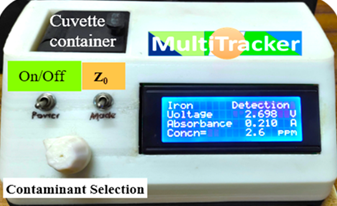The invention provides a compact, battery-powered multitracker device that uses a colorimetric technique to detect and measure concentrations of multiple water contaminants — specifically chromium (VI), arsenic (III, V), iron (II), and fluoride. The system operates with selective reagents and a single cuvette-based optical setup, supported by LEDs and photodetectors aligned with a microcontroller. The result is real-time, on-site detection of contaminants below and above WHO limits, using a simple user interface and reagent-based color changes.
Access to clean drinking water is a major public health concern due to rising contamination from industrial and natural sources. Heavy metals like chromium, arsenic, and iron, as well as non-metals like fluoride, frequently exceed permissible limits, especially in groundwater. Existing detection methods are expensive, lab-bound, and not user-friendly. There is a need for a portable, low-cost device that can detect multiple contaminants quickly and accurately in the field.
- Single-Cuvette Multi-Analyte Design: The device uses a compact cuvette holder to analyze multiple contaminants sequentially in a single container. By rotating the cuvette and switching between LEDs and photodetectors for each parameter, it eliminates the need for multiple chambers or sensors. This simplifies the hardware and reduces overall size and material cost.
- Colorimetric Detection Technique: Detection is based on visible color changes that occur when specific reagents react with contaminants like fluoride, arsenic, chromium, and iron. The LED-phototransistor setup measures the absorbance intensity of these color changes, which correlates directly to contaminant concentration. This avoids complex electrochemical or spectrometric methods while maintaining good accuracy.
- Compact and Portable Build: The device body is 3D-printed using durable PET-G material, offering a rugged yet lightweight enclosure. The assembled device measures just 19.5 cm × 12.5 cm × 8 cm and weighs about 740 grams, making it easily transportable for field testing in remote or rural locations without laboratory access.
- Low-Cost, Readily Available Components: The system is constructed using off-the-shelf components — standard LEDs matched to absorbance wavelengths, phototransistors for light detection, an Arduino Uno microcontroller for data processing, and common user-interface elements like toggle switches and LCD display. This keeps the total build cost around INR 1,935/- (approx. USD 23), making it highly affordable for widespread deployment.
- User-Friendly Operation: The user interface consists of rotary and toggle switches to select contaminants and switch between reference and measurement modes. Results are displayed in real-time on a clear LCD screen. The operation requires minimal training, making it accessible to public health workers, students, or rural technicians.
- High Specificity with Minimal Interference: Each contaminant is detected using a dedicated, selective reagent optimized to produce a unique color response. These reagents are stable and show minimal interference from other ions commonly present in natural water, ensuring accurate readings even in complex real-world samples.
- Validated Performance: The device has been tested using real water samples from lakes, tap water, and potentially contaminated sources. Results were cross-verified using laboratory-grade UV-Vis spectrophotometers and ICP-AES instruments, confirming that the multitracker provides reliable, accurate measurements across a range of concentrations.
The multitracker prototype features a 3D-printed cuvette container with holes for multiple LEDs-phototransistor pairs, aligned on opposite sides. Each LED emits at a wavelength matched to the absorbance peak of a specific contaminant-reagent complex. The device operates using an Arduino Uno microcontroller, which handles input from rotary and toggle switches to control measurement and reference modes.
Contaminant concentration is determined by measuring the change in light absorbance through the sample using the phototransistor, converted into voltage and processed through calibration curves. A liquid crystal display (LCD) shows real-time concentrations in ppm or ppb. The setup is powered by two 9 V batteries and is fully portable.
The prototype has been fabricated, tested with diverse real environmental samples like tap water, canal, lake and river water and validated with high-end instruments such as ICP-MS, ICP-AES and ion-selective electrode. Its results closely match those from high-end instruments. Reagents were found stable for up to 28 days. The device is ready for field use and scalable production.
5
This low-cost, user-friendly device empowers communities, especially in under-resourced regions, to assess water quality on-site and in real-time, potentially preventing health issues caused by long-term exposure to heavy metals and fluoride. Its affordability and simplicity could significantly improve environmental monitoring and public health awareness.
- Field water quality testing (rural, urban, industrial sites)
- Government/public health monitoring programs
- Environmental science and research labs
- Water purification and utility services
- Educational demonstration tool in chemistry and environmental engineering
Geography of IP
Type of IP
202321059479
548402

